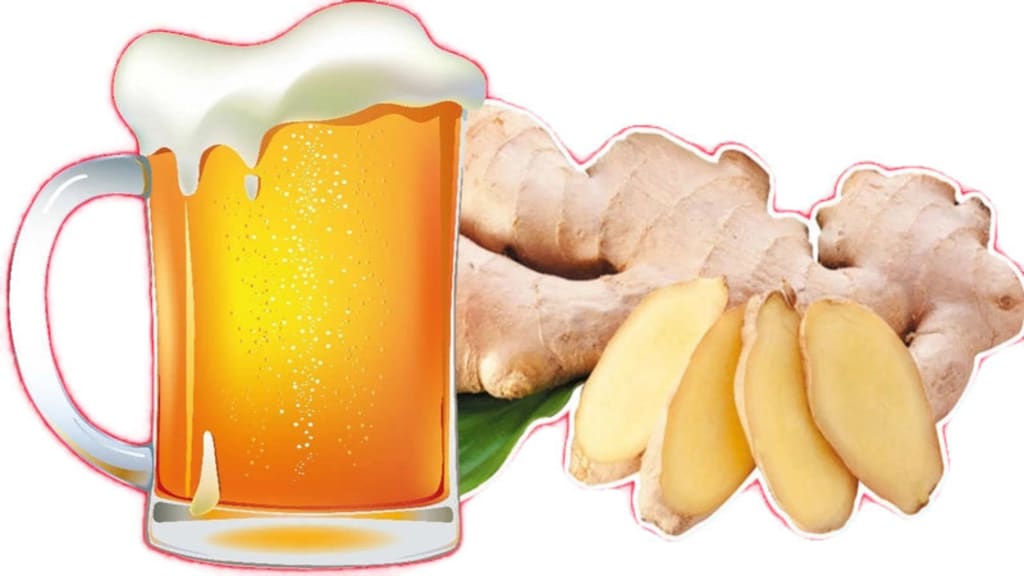Brew Your Own Ginger Beer (Ale)
A tweakcipe (tweaked recipe) for all your grumbly tummy needs.

Chances are, if your mother was born anytime after 1907, you've been given ginger beer or ginger ale at least once when you complained of an upset stomach. Well as it happens, there's a really good reason for this. Ginger is a natural anti-inflammatory agent and has antiemetic (anti-vomiting) and anti-nausea properties. As far back as 2,000 years ago, ginger root was prescribed as a digestive aid and remedy for upset stomach, diarrhea, and nausea in the form of teas and powdered medicines in India and China. As a lighter beverage, ginger beer/ale is ideal for restoring fluids to the body during intense upset stomach spells, often helping to avoid dehydration.
There's just one catch though: you only get these added health benefits if there's actually ginger in your ginger beverage. Ginger ale was originally brewed by Irish apothecary and surgeon, Thomas Joseph Cantrell, in Belfast, Northern Ireland in the 1850s. This original ginger ale is what is presently referred to as ginger beer: dark in colour, sweet to taste, with a strong ginger flavour. Ginger ale these days is clear and doesn't have the cloudiness of ginger beer, indicating its gingery-ness with residual ginger bits. This present day ginger ale can be traced back to Canadian chemist and pharmacist, John J. McLaughlin and the early 1900s. The main difference? While there is real, actual, visible ginger root in ginger beer, there is, at best, only ginger extract in ginger ale, and sometimes no ginger at all.
In the case of this ginger beer recipe, fresh ginger lends a "spicy" kick to this classic soda, and using honey instead of refined sugar helps to add sweetness to balance the ginger's spice, while allowing your diabetic grandfather to also partake. In my humble opinion, using honey as a sweetener instead of sugar actually lends a richer flavour and makes the end product fuller. And because you've used fresh ginger, this soda will help kick any stomach grumblies... in the gut...
Ingredients:
1 gallon (16 cups/3.79 L) non-chlorinated water
- The water must be non-chlorinated because chlorine can kill yeast, meaning you'll be drinking flavoured water at the end of this, not soda. If you have a refrigerator that dispenses water, this water is fine to use. Also, if you don't live in a densely populated area, tap water is fine too. Otherwise (and it REALLY pains me to have to say this) you'll have to purchase bottled water from your local grocer in order to have any chance of success with home brewing.
1 cup (8 oz/227 mL) honey
- Honey is a great natural sweetener. In this case, the yeast will "eat" the honey like it would refined sugar and this is what produces the bubbles, or carbonation.
2 lemons
1 cup (8 oz/227 mL) loosely packed hops flowers
- Optional—will make your final product taste more brew-y. Depending on where you live, this can be hard to find. But the final product will be delicious without it so don't fret if you can't find any. I actually prefer this recipe without the hops flowers so I never use them.
2 knobs of fresh ginger, thumb-sized
1/2 teaspoon (3 mL) ale or champagne yeast (Saccharomyces bayanus)
Tools You'll Need:
Stockpot
Grater
Funnel
Strainer or sieve
Plastic, screw-cap bottles or glass, flip-top bottles (however many you need to accommodate the quantity of soda you're making)
Steps:
1) Combine water, honey, and hops (if using) in a stockpot. Add the juice of two lemons and bring to a boil.
2) Grate ginger and add to pot. Simmer for 30 minutes.
- Pro tip for this step: DON'T grate the ginger directly over the boiling pot. The steam softens your knob of ginger and makes it much harder to grate. Ideally, you will have kept your ginger on the counter a few days before you get to this point so it will be a little dry and therefore stout and easier to grate. It also helps to have a fine grater, like a microplane or nutmeg grater, not a cheese grater. If you didn't know there was more than one kind of grater out there, scroll down to the 'Images' section of this Wikipedia post and then get ready to go shopping. The finer the hole of your grater, the better (and easier) your ginger will grate and the better this recipe will turn out.
3) Allow to cool completely, then add yeast.
- It is massively important to let your concoction cool to room temperature before adding the yeast. Yeast reacts faster at warmer temperatures, and can be killed off at high temperatures. If you add your yeast while your concoction is still too warm your final product will not taste like the kind of soda you're used to. I recommend giving your concoction a few good stirs to help with heat exchange and ensure the warmer liquid at the bottom has a chance to rise to the top and come into contact with the ambient air of your kitchen. Also, I shouldn't have to say this, but make sure you remove the stockpot from the hot burner (even if you have a gas stove) or you'll be waiting for ages. I like to remove mine from the heat, go watch a movie, and then come back and add the yeast after I've finished my movie. Whatever works for you, just don't add your yeast too soon.
4) Let stand at room temperature for 24 hours, then use a funnel and strainer/sieve to pour the soda into bottles, pressing on the ginger solids to extract as much of their gingery flavour as possible. Leave 1-2 inches (2.54-5.08 cm) of empty space at the top of each bottle and attach caps.
- It's essential to leave that space at the top. If you fill your bottles up too high there won't be enough room for gas expansion during the fermentation process. Put simply: when you open your bottle, expect to be cleaning your ceiling.
- As for the ginger pieces, if you want a "spicy" ginger ale you can actually pour in some of the finer ginger solids so they settle at the bottom of your bottle. This ensures a nice ginger kick, especially in the last swig.
5) Write the date on each bottle and store in a draft-free place, ideally at room temperature, for an additional 24 hours.
- If you're using plastic bottles, a handy extra perk is that your bottles will feel rock hard when you give them a gentle squeeze. This is how you know the fermentation has progressed far enough and it's time for step six.
6) Refrigerate.
- For best results, leave soda in fridge 1-2 days before consuming. This allows the soda to really chill and bring out the ginger flavour. This also slows the fermentation of the yeast, which is essential in getting a ginger-tasting soda and not a yeast-tasting soda. The latter is hugely unpleasant and how you know you've fermented too far.
7) Enjoy!
- It's best to consume any home brewed soda within two weeks, though you can store your soda in the fridge for up to four weeks. After two weeks you may notice the taste begins to change a little. This is because, while significantly slower, the fermentation process will still occur while your soda is in the fridge, bringing you closer and closer to that over-fermented endpoint.
- A word of Caution: when opening your bottles for the first time, if you are using a glass bottle with a flip-top, DO NOT stand over your bottle! Point your bottle away from you and ideally open in/over a sink (this goes for plastic bottles too). It's always tricky to time the fermentation process just right, especially if this is you first foray into home brewing. If you over-ferment your soda, there will be a considerable amount of pressure built up in the bottle and this pressure will result in some rather impressive eruptions. Best to not lose an eye in the process.
What to Expect:
This isn't going to taste exactly like the commercial soda you're probably used to. Because you're achieving your brewed soda through the natural process of fermentation, the bubbles of your homemade soda will be softer and there will be less fizz than in commercial sodas. This is because, in the commercial variety, the carbonation comes from carbon dioxide gas being injected into the beverage under pressure. This also means that you won't ever have that unpleasant sensation of bubbles fizzing up your nose when you tip your glass to take a drink.
For those of you with a powerful sweet tooth, time is your enemy in this case. The concoction you initially brew will taste very sweet because of the honey, but once you add the yeast it immediately starts converting the sugar into the by-product that makes soda bubbly. If you want your soda at its sweetest, consume within the first week after brewing. If you don't like sweet things as much, you can let yours sit for a week before opening to allow for more of the sugar—and thus more of the sweetness—to be consumed by the yeast.
At the expense of sounding like a major downer, expect to be disappointed. That way, when it works out deliciously, you're pleasantly surprised! Home brewing is a fickel science and very hard to get right the first time. There are also a lot of factors that impact the quality and outcome of your soda. For one, if you live at altitude, that will impact your pressure and in turn the pressure of your soda. (It's a very bad idea to take fermenting soda on a roadtrip across a pressure gradient. Ask me how I know.) In this case, glass bottles are better to use and leaving extra room at the top of your bottles is recommended. For another, ambient humidity and temperature can also affect the outcome of your home brewing experiment. In more hot and humid climates, it's a good idea to have a "brewing cupboard" or a cleared out space in your pantry where it's dark and dry to store your soda bottles while they're fermenting. In lieu of a brewing cupboard, try wrapping a towel around your bottles to keep out the light.
And finally, expect to have fun! Brewing your own soda is like doing a chemistry experiment, except this time you actually get to consume what you create! Don't get discouraged if it doesn't work out the first time. Often times, most nasty soda experiences can be solved by tweaking the amount of yeast you use, the length of time you allow it to ferment for, and the cleanliness of your bottles. A good clean bottle (and funnel) is essential for producing the best tasting soda. If you have an electric dishwasher, a run through the normal cycle is all you need. If washing by hand, make sure to use hot water—as hot as you can stand—and a mild dish soap. The key here is to thoroughly rinse out all the soap and dry your bottles completely so there is no residue.
As a side note, if you leave out the yeast, the start of this recipe also makes for a brilliant cold weather tonic. Leaving out the yeast means you can store your concoction in the fridge indefinitely and then just warm some up on a cold day to help with sore throats, cold aches, etc. If you want an extra-powerful health kick, just add the contents of a ginseng tea bag to the boiling step. The resulting concoction will have you feeling tip top in no time!
I love experimenting in the kitchen and I'm always trying out new recipes. If there's anything specific you'd like me to try, and then write about, feel free to shoot me a message on Instagram and then keep an eye out for the (tweaked) recipe here.
About the Creator
Alana Boyles
A lifelong aspiring writer with a Master's Degree in Marine Biology & Ecology.
Passions include literature, music, travel, and environmentalism.
Follow along on IG @alanalb93, creator of @pendragon_studios and @forever_epigram.
Enjoyed the story? Support the Creator.
Subscribe for free to receive all their stories in your feed. You could also pledge your support or give them a one-off tip, letting them know you appreciate their work.






Comments
There are no comments for this story
Be the first to respond and start the conversation.